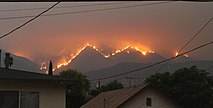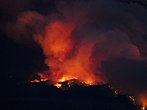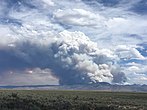| 2020 California wildfires | |
|---|---|
From top to bottom, and left to right; September 10 satellite image of the wildfires burning in California and Oregon; The Aurora Fire on June 26, 2020; The Bobcat Fire burning in the San Gabriel mountains near Monrovia; Smoke from the North Complex over the Bay Bridge at noon on September 9; An orange sky over Eureka on Sept 9; The CZU Lightning Complex fires along Butano Ridge on August 18; The Loyalton Fire near Calpine; The Hennessey and Spanish Fires burn towards Lake Berryessa on August 18, 2020 | |
| Date(s) | February 15, 2020 – January 5, 2021 |
| Statistics[1] | |
| Total fires | 8,648 |
| Total area | 4,304,379 acres (1,741,920 ha) |
| Impacts | |
| Deaths | 33[1] |
| Non-fatal injuries | 37[1] |
| Structures destroyed | 11,116 (Cal Fire)[1] 9,211 (NIFC)[2] |
| Damage | >$12.079 billion (2020 USD) (Third-costliest on record)[3][2] |
| Map | |
 A map of wildfires in California in 2020, using Cal Fire data | |
| Season | |
← 2019
2021 → | |
| 2020 Western U.S. wildfires |
|---|
 |


The 2020 California wildfire season, part of the 2020 Western United States wildfire season, was a record-setting year for wildfires in California. Over the course of the year, 8,648 fires burned 4,304,379 acres (1,741,920 ha),[1][2] more than four percent of the state's roughly 100 million acres of land, making 2020 the largest wildfire season recorded in California's modern history.[4][5] However, it is roughly equivalent to the pre-1800 levels which averaged around 4.4 million acres yearly and up to 12 million in peak years.[6] California's August Complex fire has been described as the first "gigafire", burning over 1 million acres across seven counties, an area larger than the state of Rhode Island. The fires destroyed over 10,000 structures[1] and cost over $12.079 billion (2020 USD) in damages, including over $10 billion in property damage and $2.079 billion in fire suppression costs.[3][2] The intensity of the fire season has been attributed to a combination of more than a century of poor forest management[7][8] and higher temperatures resulting from climate change.[9][10]
On August 18, Governor Gavin Newsom declared a state of emergency,[11] and on August 19, 2020, reported that the state was battling 367 known fires, many sparked by intense thunderstorms on August 16–17 caused by moisture from the remnants of Tropical Storm Fausto. Response and evacuations were complicated by a historic heatwave and the ongoing COVID-19 pandemic. On August 22, President Donald Trump issued a major disaster declaration (DR-4558), which provides Individual Assistance and/or Public Assistance.
In early September 2020, a combination of a record-breaking heat wave and strong katabatic winds, (including the Jarbo, Diablo, and Santa Ana) caused explosive fire growth. The August Complex became California's largest recorded wildfire.[12] The Creek Fire expanded in the Big Creek drainage area, temporarily trapping hundreds of campers near the Mammoth Pool Reservoir. The North Complex explosively grew in size as the winds fanned it westward, threatening the city of Oroville, triggering mass evacuations, and causing 16 fatalities.[13]
Governor Newsom's request for a federal disaster declaration for six major wildfires was approved on October 17 after having been rejected the previous day.[14][15]
- ^ a b c d e f "Fire Statistics". CAL FIRE. January 2, 2021. Archived from the original on June 28, 2020. Retrieved January 2, 2021.
- ^ a b c d 2020 National Large Incident Year-to-Date Report (PDF). Geographic Area Coordination Center (Report). National Interagency Fire Center. December 21, 2020. Archived from the original (PDF) on December 29, 2020. Retrieved January 13, 2021.
- ^ a b David Louie (October 9, 2020). "Damage from California's wildfires estimated at $10 billion, experts say". Abc7 San Francisco. ABC, Inc. Archived from the original on January 27, 2021. Retrieved January 14, 2021.
- ^ Holly Yan; Cheri Mossberg; Artemis Moshtaghian; Paul Vercammen (September 6, 2020). "California sets new record for land torched by wildfires as 224 people escape by air from a 'hellish' inferno". Cable News Network. Archived from the original on September 6, 2020. Retrieved September 6, 2020.
- ^ Silverman, Hollie (September 8, 2020). "California wildfires have burned more than 2 million acres and prompted power outages for more than 170,000". CNN. Archived from the original on September 8, 2020. Retrieved September 8, 2020.
- ^ Stephens, Scott L.; Martin, Robert E.; Clinton, Nicholas E. (November 15, 2007). "Prehistoric fire area and emissions from California's forests, woodlands, shrublands, and grasslands". Forest Ecology and Management. 251 (3): 205–216. Bibcode:2007ForEM.251..205S. doi:10.1016/j.foreco.2007.06.005. ISSN 0378-1127. Archived from the original on August 12, 2018. Retrieved October 29, 2020.
Lacking from current wildfire discussions are estimates of the spatial extent of fire and their resultant emissions before the influences of Euro-American settlement and this is the focus of this work. We summarize the literature on fire history (fire rotation and fire return intervals) and past Native American burning practices to estimate past fire occurrence by vegetation type. ... Approximately 1.8 million ha burned annually in California prehistorically (pre 1800).
- ^ Rogers, Paul (August 23, 2020). "California fires: State, feds agree to thin millions of acres of forests – New plan would last 20 years, reshaping California's landscape". San Jose Mercury News. Archived from the original on September 13, 2020. Retrieved September 11, 2020.
Before the Gold Rush in 1849, large parts of California burned every few decades. Lightning fires burned for months, and native tribes burned the land, clearing out dead vegetation. ... Stephens, the UC fire scientist, estimates that before the Gold Rush, roughly 4.5 million acres a year in California burned. By the 1950s and 1960s, that was down to about 250,000 acres a year.
- ^ Cite error: The named reference
why won't anybody listenwas invoked but never defined (see the help page). - ^ Cite error: The named reference
:0was invoked but never defined (see the help page). - ^ Cite error: The named reference
techrev20200820was invoked but never defined (see the help page). - ^ Singh, Maanvi (August 19, 2020). "California wildfires: thousands evacuate as 'siege' of flames overwhelms state". The Guardian. Archived from the original on August 19, 2020. Retrieved August 19, 2020.
- ^ Michele Chandler (September 11, 2020). "What we know Thursday about North State fires: Elkhorn merges with August Complex to create 726K-acre monster". Redding.com. Redding Record Searchlight. Archived from the original on September 17, 2020. Retrieved September 11, 2020.
- ^ "California wildfires: Gov. Gavin Newsom tours North Complex fire destruction, declares statewide emergency". ABC 7 News. September 11, 2020. Archived from the original on November 20, 2022. Retrieved November 20, 2022.
- ^ Kelly, Caroline (October 17, 2020). "Trump reverses course and grants California's wildfire disaster declaration request". CNN. Archived from the original on February 15, 2021. Retrieved October 17, 2020.
- ^ Fuller, Thomas; Taylor, Derrick Bryson (October 16, 2020). "In Rare Move, Trump Administration Rejects California's Request for Wildfire Relief". The New York Times. ISSN 0362-4331. Archived from the original on October 16, 2020. Retrieved October 16, 2020.







